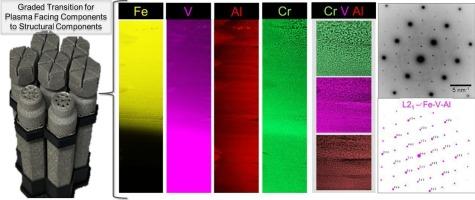Bonding of vanadium- and Iron-based alloys as interlayers for plasma-facing and structural materials in fusion systems
IF 7.9
2区 材料科学
Q1 MATERIALS SCIENCE, MULTIDISCIPLINARY
引用次数: 0
Abstract
Vanadium alloys and FeCrAl were investigated as interlayers between tungsten and reduced activation ferritic martensitic steel for fusion system components to avoid formation of intermetallic phase at operating temperatures between 550 and 1100 °C, while maintaining a body centered cubic phase throughout the interface. Physical and mechanical properties need to be graded between tungsten and steel, but recent results showed a significant hardness increase at the FeCrAl to vanadium alloy interface. Here, a sintered sample of these alloys was annealed for extended time, and the microstructure was investigated to provide a better understanding of the phenomena. A comparison with an additively manufactured interface of the same material is provided. An unexpected L21 intermetallic phase formation has been revealed using microscopy and synchrotron techniques and will inform future additive manufacturing approaches of the interface. A Cr layer interface as a preliminary solution was proposed between the Vanadium alloy and FeCrAl alloy interface.

熔合系统中用作等离子体表面和结构材料中间层的钒和铁基合金的键合
研究了钒合金和FeCrAl作为钨和还原活化铁素体马氏体钢之间的中间层,在550 ~ 1100℃的熔合系统组件中避免了金属间相的形成,同时在整个界面中保持了一个以体心为中心的立方相。物理和机械性能需要在钨和钢之间进行分级,但最近的研究结果表明,铁铁合金与钒合金界面的硬度显著提高。在这里,对这些合金的烧结样品进行了长时间的退火,并研究了显微组织,以更好地理解这一现象。提供了与相同材料的增材制造界面的比较。使用显微镜和同步加速器技术发现了意想不到的L21金属间相形成,这将为未来的增材制造界面方法提供信息。提出了Cr层界面作为钒合金与FeCrAl合金界面之间的初步解决方案。
本文章由计算机程序翻译,如有差异,请以英文原文为准。
求助全文
约1分钟内获得全文
求助全文
来源期刊

Materials & Design
Engineering-Mechanical Engineering
CiteScore
14.30
自引率
7.10%
发文量
1028
审稿时长
85 days
期刊介绍:
Materials and Design is a multi-disciplinary journal that publishes original research reports, review articles, and express communications. The journal focuses on studying the structure and properties of inorganic and organic materials, advancements in synthesis, processing, characterization, and testing, the design of materials and engineering systems, and their applications in technology. It aims to bring together various aspects of materials science, engineering, physics, and chemistry.
The journal explores themes ranging from materials to design and aims to reveal the connections between natural and artificial materials, as well as experiment and modeling. Manuscripts submitted to Materials and Design should contain elements of discovery and surprise, as they often contribute new insights into the architecture and function of matter.
 求助内容:
求助内容: 应助结果提醒方式:
应助结果提醒方式:


